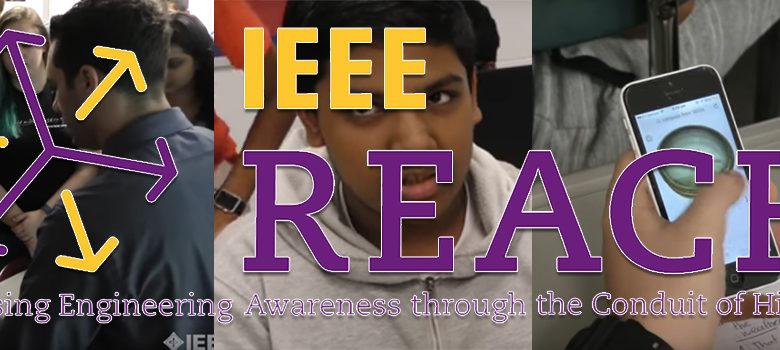
Excitement, intrigue and laughter filled two global history classrooms at Manalapan High School in New Jersey on 10 June 2016, when history teachers Brian Sullivan and James Somma introduced the IEEE History Center’s first REACH pilot in their classrooms.
Readers of this history column in IEEE-USA Insight are aware of the IEEE History Center and its mission to demonstrate that technology and history are not mutually exclusive subjects. However, you may not be aware that the History Center has been working on promoting that message to pre-college students. A year ago, I was hired as the Program Manager for a new “Signature Program” of the IEEE Foundation. IEEE REACH (Raising Engineering Awareness through the Conduit of History) offers high-school history teachers resources that delve deeper into the complex and often complicated interrelationship between the technology and history. Since coming on board, I and my fellow members of the History Center staff have been working hard to complete the content for the first few units on the topic, and also the website that will deliver the content to teachers throughout the United States.
The complex relationship between navigational technology, its advances, its place in history, and its impact on economics and society in the early modern period are the premise for the first REACH unit to get out of the gate, and a major step forward has been taken with this first pilot, the maritime navigation unit. As the Program Manager, it was wonderful for me to see the program come to life and watch how the students reacted to all the elements that encompass REACH. It was particularly exhilarating to observe students as they grasped the concepts of how the technologies of early maritime navigation affected the relative preeminence of different societies.
The History Center’s Senior Historian Dr. John Vardalas, now retired, worked with Michelle Lilley, Manalapan High School’s Social Studies Supervisor, to create the inquiry unit (lesson plans) for the maritime navigation pilot, including hands-on activities. In addition, Dr. Vardalas provided the teachers with background information on the history of the technologies tied to maritime navigation in the early modern period, and its relevance to the other social, political, economic and military changes taking place at that time. Dr. Vardalas emphasized the importance of understanding the power of the sea, pointing out that Sir Walter Raleigh proclaimed, at the close of the 16th century: “He that commands the sea, commands the trade, and he that is Lord of trade of the world is Lord of the wealth of the world.”
Finding one’s way across the oceans, however, was far more difficult than navigating on land, and the penalty for error was often deadly. The very difficult challenge of navigating across the world’s vast an undifferentiated ocean had to be mastered. To command the hostile environment of the sea, advances in science and engineering were essential.
The piloted lesson plan was on the magnetic compass, originally developed by the Chinese and widely regarded as one of the greatest inventions of all time. It also highlighted Portolan charts, a European invention that enabled the compass to achieve its full potential as a revolution in navigation. The full inquiry unit further explores the evolution of technologies associated with determining latitude and the quest to find longitude, both essential to mastering seafaring navigation. This REACH inquiry unit brings awareness of how the necessity to master the sea was a powerful engine that drove both science and engineering, and how maritime navigational engineering and advancements in technology enabled European societies to gain global preeminence. It then comes full circle by showing how today’s navigational technologies, such as the GPS, are based on some of the same concepts developed hundreds of years ago and yet continue to affect society today.
The Manalapan students who participated in the REACH pilot walked away with new knowledge and a richer understanding of the relationships between technology and history. As Veronica Feather, one of the students in the Manalapan pilot expressed, “If society needs to advance, it will ask something of technology and science, but sometimes science will advance faster than society, and in turn that will advance society.”
Interested in science and engineering, as well as philosophy, Shreyas Selvaraj, another Manalapan student explained, “”¦there is a whole other side to knowledge and how you can view the world. It’s really interesting to find the connections between STEM and the Humanities and what we have learned here is food for thought.”
The IEEE REACH pilot was not only a success with the students, but also with the teachers. Social Studies Supervisor Michelle Lilley proclaimed, “My experience with IEEE has enlightened me to the importance of including scientific processes as a part of history; our progress as humans and societies is contingent upon new ideas becoming a reality. Engaging students in hands-on experiences allowed them to make connections between science and history; reinforcing their understanding of the challenges faced by past generations and providing them with insight to those they may face in their lifetimes.”
Other units in the pipeline include Greek triremes, the Printing Press, and broadcast radio. History Center staff also presented and exhibited about REACH at the fall 2016 meetings of the New Jersey Council for the Social Studies, the National Council for the Social Studies, and the Council of State Social Studies Specialists. The beta version of the website will be ready by the end of the year. Look for publicity from the History Center when the program finally launches early next year.
In the meanwhile, you can enjoy a video of the first REACH pilot in the classroom at: https://www.youtube.com/watch?v=h0G0U_Ukp7g
Kelly McKenna is program manager for the IEEE REACH program.






